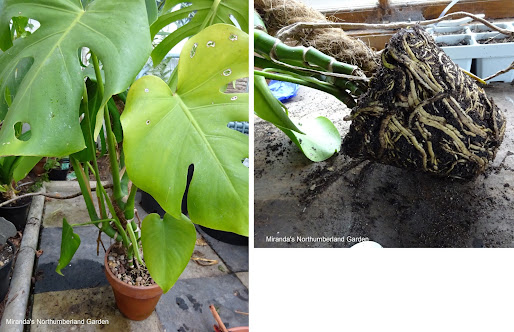Here in Northumberland for the last three weeks we have had continuous torrential rain, gales and heavy snow fall. The garden is sodden everywhere, it squelches when I walk to the guinea pig shed, even in the fruit cage where the ground is covered in a thick mulch of composted woody shreddings I can feel the ground is saturated. I feel I really should be doing something horticulturally related in order to lift my spirits. Obviously doing anything outside is out of the question so I decided to sort out my glasshouse. I do this annually generally in about April but this year I might as well to do it a bit earlier and I thought you might be interested to see what I do in order to maintain the plants in this artificial environment.
This gloomy picture taken from the bathroom window looking east doesn't inspire me to do anything except stay indoors.
Yes, I know, it looks quite a mess. Dead leaves and fern fronds litter the floor; everything needs to be checked for signs of decay, dead leaves cut away and checking which plants need to go into bigger pots.
On the left near the door there is a fern, I’m not sure of its name but it’s been in that spot for a few years and it seems very happy, the dead and half dead foliage just needs to be trimmed off to make room for new growth.
Next I have two Vietnamese coriander plants which are still in the plastic pots they were in when I bought them from the garden centre. Apparently they are very vigorous, so they just need to go into bigger pots with fresh compost. I bought these because of their tropical appearance but I should really try using them in cooking.
Next is Zantedeschia, only a few straggly leaves need attention.
This is one of many small Musella lasiocarpas I have (hardy Golden Lotus banana). Again dead leaves are removed and they are checked to see if any roots are bursting out of the bottom, if so into a bigger pot they go.
As you can see from this picture Hedychium aurantiacum has outgrown its pot – so needs repotting.
Not so
for the Monstera deliciosa, as you can see its roots are badly congested, a
few minutes later and a happy plant.
This corner is jam packed - in the front there is a potted Geranium maderense, which I brought in for the winter as in previous years I’ve lost them.
Behind
is a Bougainvillea in winter dormancy, also in this group of pots is an avocado
which I grew from seed and at the back on the far right is a Cestrum elegans
and an abulilton.
This rabbits foot fern (Davallia canariensis) is growing quite happily in a large plastic aquatic basket, I find these pots are ideal for aerial plants.
After I had finished the glasshouse was tidy and every plant looked a whole lot better. All that was left to do was to cover all exposed compost with Strulch. I find Strulch deters slugs and snails from damaging the plants; it also helps the soil retain moisture.



















































